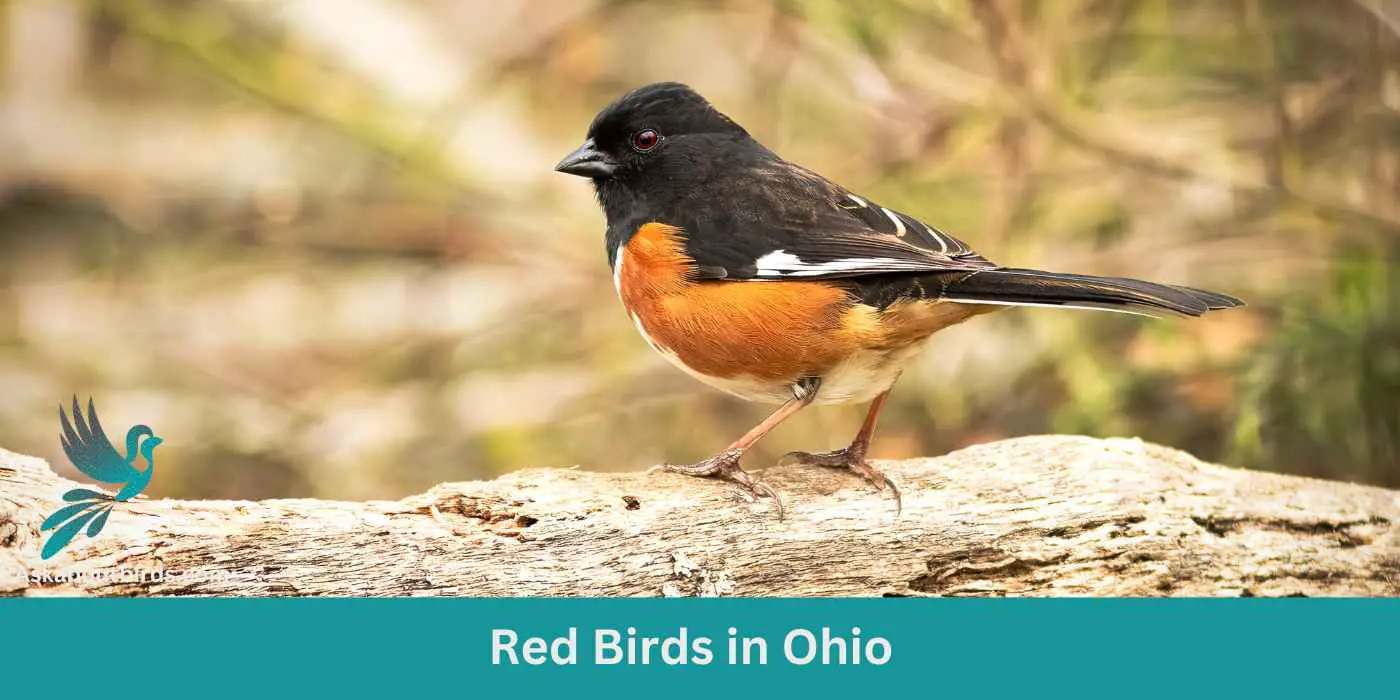From the gentle roll of its plains to the bustling urban centers, Ohio’s diverse landscapes are a symphony of colors and sounds. Among these vibrant notes, the state boasts a collection of red-feathered wonders that capture the hearts of bird enthusiasts.
Join us as we unravel the beauty of 11 distinct red birds in Ohio through our comprehensive photo guide. Whether you’re a seasoned birder or a curious novice, this guide promises a visual treat and an enriching experience.
Red Birds Found In Ohio
Nestled in the heart of the Midwest, Ohio’s rich tapestry of habitats offers a welcoming haven for a myriad of bird species. The state’s diverse geography, from the shores of Lake Erie in the north to the Appalachian foothills in the south, creates a mosaic of ecosystems.
This diversity, coupled with its location along migratory pathways, makes Ohio a crucial stopover for birds traversing vast distances.
Northern Cardinal


| Feature | Measurement |
|---|---|
| Scientific Name | Cardinalis cardinalis |
| Length | 8.3 – 9.1 in |
| Wingspan | 9.8 – 12.2 in |
| Weight | 1.19 – 2.29 oz |
The Northern Cardinal is an iconic North American bird, easily recognized by its vibrant color and melodious song.
Appearance: Male Northern Cardinals are a brilliant scarlet red, while females display a more subdued reddish olive. Both sexes have a distinctive black ‘mask’ on their face around the bill and a pointed crest on their head. The bird’s beak is robust, cone-shaped, and bright orange in color.
Diet: Northern Cardinals are primarily granivorous, with a diet largely consisting of seeds and grains. They also eat fruits and insects. These birds typically feed off the ground and are frequent visitors to bird feeders.
Reproduction: Northern Cardinals are monogamous, and a pair will breed together for life. The female typically builds a well-hidden nest in a dense thicket or shrub. She lays 2-5 eggs per clutch, which she incubates for around two weeks.
Red-Winged Blackbird
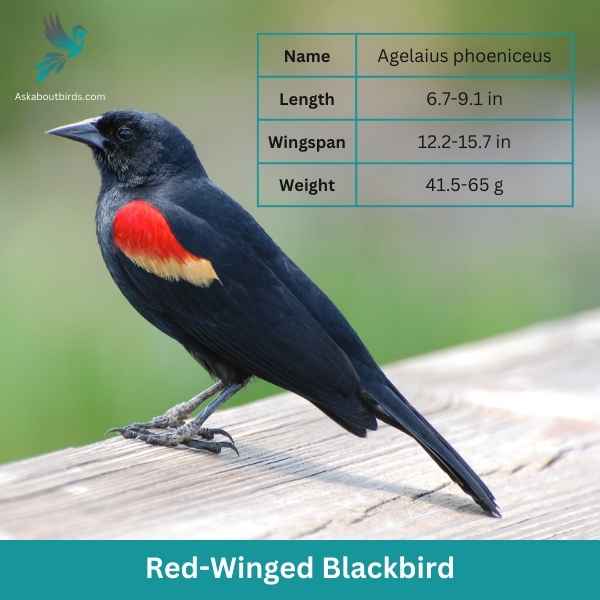
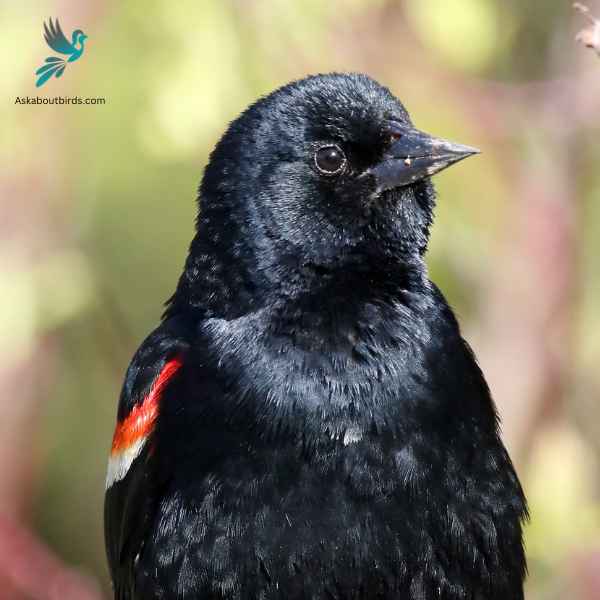
| Feature | Measurement |
|---|---|
| Scientific Name | Agelaius phoeniceus |
| Length | 6.7-9.1 in |
| Wingspan | 12.2-15.7 in |
| Weight | 41.5-65 g |
The Red-Winged Blackbird is a familiar sight across North America, especially in wetlands and open areas. Known for its striking coloration and distinct call, it is often seen perched on cattails or utility lines.
Appearance: Male Red-Winged Blackbirds are glossy black with bright red-and-yellow shoulder patches, while females are streaky brown, resembling a large sparrow. The males’ red patches become more prominent when they’re displaying or agitated.
Diet: Red-Winged Blackbirds primarily feed on seeds and insects. Their diet includes grains, sunflower seeds, and corn, but they also eat beetles, caterpillars, and other small invertebrates, especially in the breeding season.
Reproduction: Red-Winged Blackbirds nest in marshes, along watercourses, and in wet fields. The female constructs a cup-shaped nest using grass and sedge, attaching it to plants above water. She typically lays a clutch of 3 to 4 blue-green eggs, which she incubates for about 11-12 days. Males, being polygynous, often have multiple mates during a single breeding season.
Summer Tanager


| Feature | Measurement |
|---|---|
| Scientific Name | Piranga rubra |
| Length | 6.7 in |
| Wingspan | 28 to 30 cm |
| Weight | 29 g |
The Summer Tanager is a medium-sized songbird admired for its radiant plumage and melodious song.
Appearance: Male Summer Tanagers are an impressive bright red, while females and juveniles present a softer, yellow-orange color. Both genders have a large, slightly hooked bill and relatively short tail.
Diet: Summer Tanagers primarily feed on insects, including bees and wasps, which they catch in flight or pick off vegetation. They are also known to eat fruits and berries, making them helpful in controlling pest populations and seed dispersal.
Reproduction: The female Summer Tanager builds a loose, shallow cup-shaped nest out of twigs and grass, usually hidden in the foliage of trees. The female typically lays 3-5 eggs, which she will incubate for about two weeks.
Scarlet Tanager


| Feature | Measurement |
|---|---|
| Scientific Name | Piranga olivacea |
| Length | 6.3 to 7.5 in |
| Wingspan | 9.8 to 11.8 in |
| Weight | 23.5 to 38 g |
The Scarlet Tanager is a strikingly colorful bird known for its brilliant plumage and distinctive song.
Appearance: Male Scarlet Tanagers are notable for their vibrant scarlet bodies contrasted with black wings and tail, making them one of the most intensely colored birds. Females and juveniles, on the other hand, have a subdued olive-yellow body color with darker wings and tail.
Diet: The diet of the Scarlet Tanager is largely made up of insects, including beetles, cicadas, aphids, and others. They are adept flycatchers, seizing insects in mid-air or picking them off foliage. They also consume fruits and berries, especially during migration and in their winter habitats.
Reproduction: The female Scarlet Tanager builds a cup-shaped nest using twigs, rootlets, and grass, typically well-hidden in the dense foliage of trees. She lays 3 to 5 eggs and incubates them for about two weeks.
Red-bellied Woodpecker
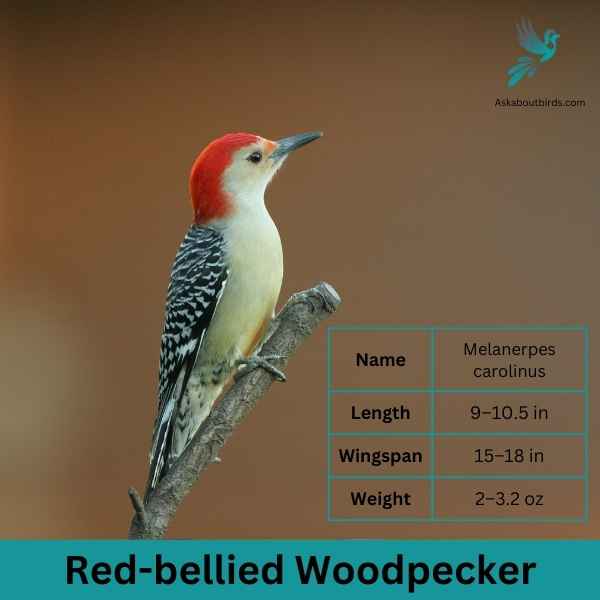
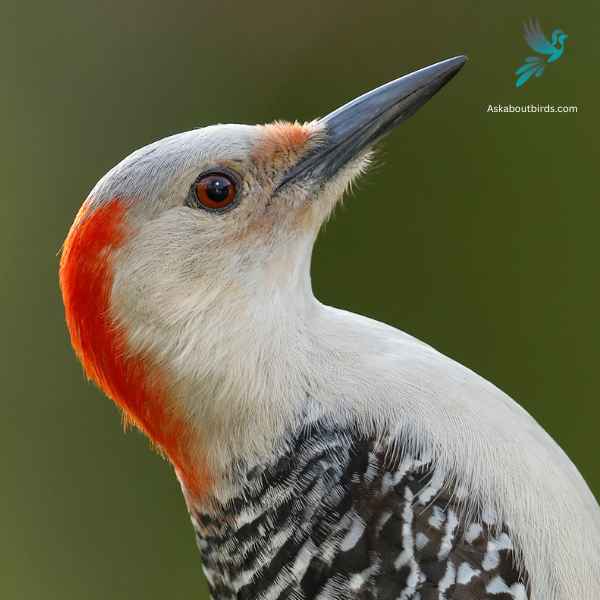
| Feature | Measurement |
|---|---|
| Scientific Name | Thryothorus ludovicianus |
| Length | 4.7–5.5 in |
| Wingspan | 11 in |
| Weight | 0.63–0.81 oz |
The Red-bellied Woodpecker is a medium-sized woodpecker commonly found in woodlands, forests, and backyards across the eastern and central U.S.
Appearance: The Red-bellied Woodpecker sports a pale gray face, throat, and belly, contrasted by a zebra-striped back. Its name derives from the subtle reddish tinge on its belly, but it’s more commonly recognized by the vivid red cap on the head of males and the partial red cap on females.
Diet: This woodpecker has a varied diet that includes insects, fruits, nuts, and seeds. They frequently forage on tree trunks and branches, using their sticky, barbed-tipped tongue to extract ants, beetles, and other insects from crevices.
Reproduction: Red-bellied Woodpeckers are cavity nesters, excavating holes in tree trunks for their nests. The inside of the nest is typically unlined or sparingly lined with wood chips.
House Finch


| Feature | Measurement |
|---|---|
| Scientific Name | Haemorhous mexicanus |
| Length | 5–6 in |
| Wingspan | 8–10 in |
| Weight | 0.6–0.9 oz |
The House Finch is a small songbird widely distributed across North America and is commonly found in urban and suburban areas.
Appearance: Males of this species are brightly colored with crimson faces and throats, which can extend to the chest and back, while their flanks have streaks. The female is streaked brown and lacks the red coloring. Both have a square-tipped tail and a distinctively long, flat-topped bill.
Diet: House Finches primarily eat seeds, grains, and berries. They have a particular fondness for sunflower seeds and can be commonly seen at bird feeders. Occasionally, they will also consume insects, especially during the breeding season.
Reproduction: House Finches are cavity-nesters and might choose ledges, vents, ledges, and other urban settings. They might also utilize trees or shrubs. Their nests can be made of a wide array of materials, from feathers to twigs.
Pine Grosbeak

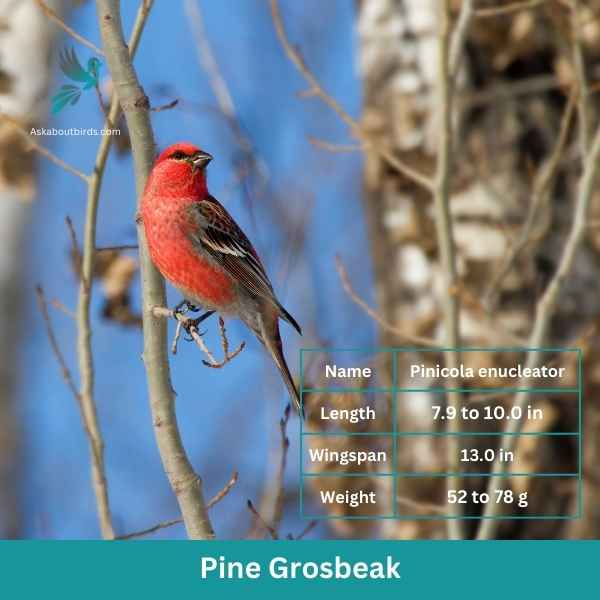
| Feature | Measurement |
|---|---|
| Scientific Name | Pinicola enucleator |
| Length | 7.9 to 10.0 in |
| Wingspan | 13.0 in |
| Weight | 52 to 78 g |
The Pine Grosbeak is a striking bird native to the northern regions of North America, often found in coniferous forests. Both males and females have a plump and robust body with a large beak adapted for eating seeds. The male Pine Grosbeak displays a vibrant reddish-pink plumage, while the female has a more subdued grayish-brown coloration.
These birds are typically seen in small flocks, foraging for food in trees and on the ground. They have a preference for seeds, particularly those from various conifer species. The Pine Grosbeak uses its strong bill to crack open the cones of tall trees and extract the seeds, but they also consume berries and small fruits when available.
Red Crossbill

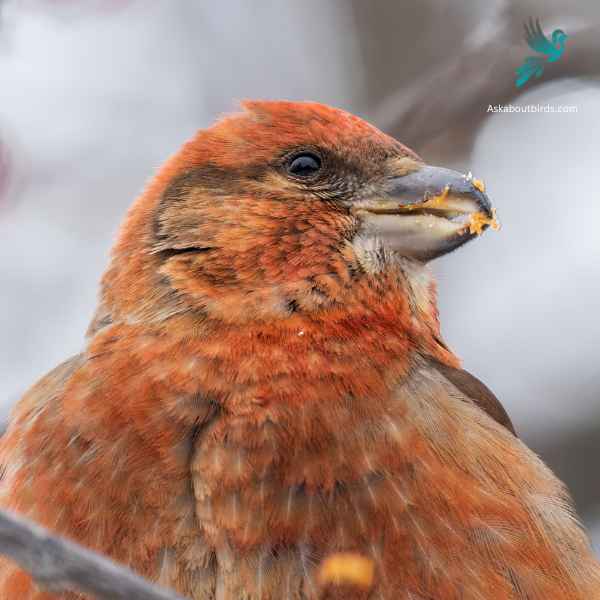
| Feature | Measurement |
|---|---|
| Scientific Name | Loxia curvirostra |
| Length | 5.5–7.5 in |
| Wingspan | 9.8–10.6 in |
| Weight | 0.9–1.4 oz |
The Red Crossbill is a distinctive finch known for its unusual bill, which has evolved to extract seeds from conifer cones.
Appearance: Males are typically bright red or orange, while females are greenish-yellow or olive. Both genders have the characteristic crossed bill, which they use to expertly extract seeds from tightly closed conifer cones.
Diet: Red Crossbills primarily feed on the seeds of coniferous trees, such as spruce, pine, and fir. Their specialized bills allow them to efficiently pry apart conifer cone scales to access the seeds.
Reproduction: Red Crossbills are somewhat nomadic and don’t adhere to a strict breeding schedule. Instead, they breed whenever and wherever food is abundant. Their nests are usually built on horizontal branches of conifer trees.
Red-headed Woodpecker

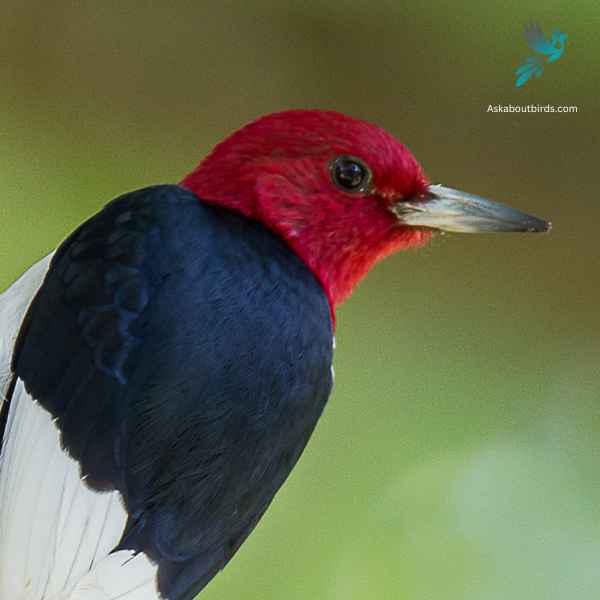
| Feature | Measurement |
|---|---|
| Scientific Name | Melanerpes erythrocephalus |
| Length | 7.5–9.1 in |
| Wingspan | 16.5 in |
| Weight | 2.0–3.2 oz |
The Red-headed Woodpecker is a striking forest bird with a bold tri-colored pattern.
Appearance: This woodpecker features a completely red head and neck, contrasting starkly with its white underparts and black wings. Its wings also have large white patches which are conspicuous in flight.
Diet: Red-headed Woodpeckers have a varied diet including insects, seeds, fruits, berries, and occasionally even the eggs of other birds. They’re also known to store food by wedging it into crevices in bark.
Reproduction: These woodpeckers nest in cavities which they excavate in dead wood or dead parts of live trees. These cavities can be found anywhere from 2 to 80 feet off the ground.
Rose-breasted Grosbeak
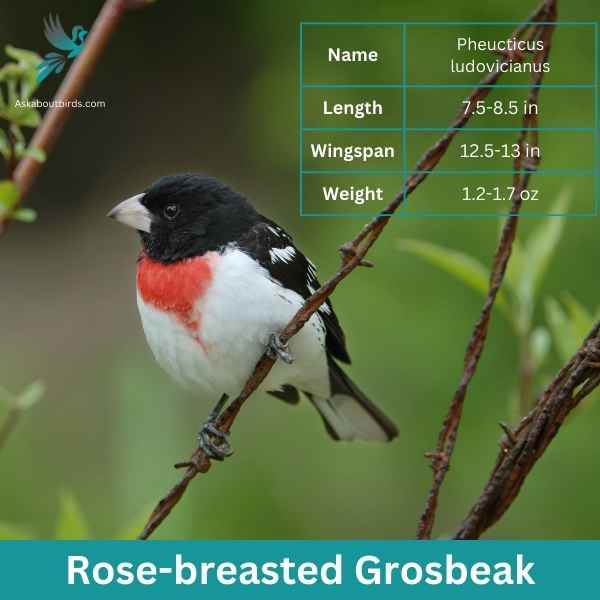

| Feature | Measurement |
|---|---|
| Scientific Name | Pheucticus ludovicianus |
| Length | 7.5-8.5 in |
| Wingspan | 12.5-13 in |
| Weight | 1.2-1.7 oz |
The Rose-breasted Grosbeak is a songbird of medium size, widely recognized for its vibrant coloration and melodious song.
Appearance: Male Rose-breasted Grosbeaks boast a striking contrast with black and white plumage accompanied by a radiant rose-colored patch on the chest and under the wings. In contrast, females exhibit streaked brown and white plumage, resembling large sparrows but with a thick bill.
Diet: The diet of the Rose-breasted Grosbeak consists of a mixture of seeds, insects, and fruits. During summer, they primarily feed on insects, while seeds and fruits become more prevalent in their diet during the colder months.
Reproduction: These birds build cup-shaped nests typically situated in trees or large shrubs. Both the male and female partake in incubation duties, ensuring the eggs’ safety and warmth. After hatching, the chicks are primarily fed insects.
Eastern Towhee

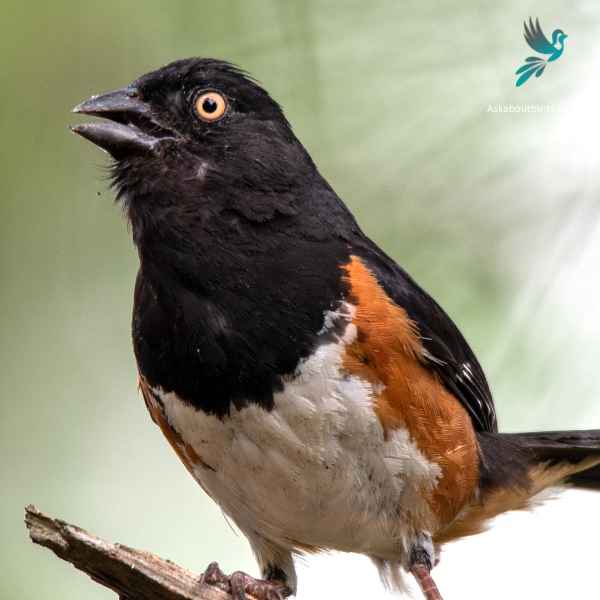
| Feature | Measurement |
|---|---|
| Scientific Name | Pipilo erythrophthalmus |
| Length | 6.8 to 9.1 in |
| Wingspan | 7.9–11.8 in |
| Weight | 32 to 53 g |
The Eastern Towhee is a distinctive songbird known for its unique calls and eye-catching coloration.
Appearance: Male Eastern Towhees are characterized by a striking combination of a black head, back and tail, contrasting with a white belly and rufous flanks. Females sport similar patterns but instead of black, they have a rich brown color. Both genders have red eyes, lending a special charm to their overall appearance.
Diet: Eastern Towhees primarily feed on a variety of insects, seeds, and berries. Their diet is quite diverse, taking advantage of seasonal offerings, which includes beetles, caterpillars, spiders, acorns, grass seeds, and various fruits and berries.
Reproduction: Eastern Towhees build their nests on or near the ground, often in a shrub or a small tree. The female lays around 3-5 eggs and takes the primary role in incubating them over about 12-13 days.
Where to Spot Ohio’s Red Birds
Discover the vibrant avian treasures of Ohio as we take you through the state’s top birding locales.
- Magee Marsh Wildlife Area: Renowned as the “Warbler Capital of the World”, Magee Marsh sees an astonishing variety of birds during migration seasons, especially in spring. Its boardwalk offers unparalleled views of red birds and countless others.
- Cuyahoga Valley National Park: Spanning 33,000 acres, this national treasure between Cleveland and Akron offers diverse habitats, from wetlands to forests, drawing a wide range of birds, including the stunning Scarlet Tanager.
- Shawnee State Park: Located in the Appalachian foothills, this park is a haven for woodland birds. Its dense forests are perfect for spotting an array of red-hued species amidst the lush greenery.
- Ottawa National Wildlife Refuge: Nestled along Lake Erie’s western basin, this refuge is a significant stopover for migratory birds. The mix of marshes, open water, and grasslands attracts diverse bird species, making it a must-visit for spotting vibrant red birds.
- Clear Fork Reservoir: This reservoir, with its surrounding woodlands and grassy areas, attracts a variety of waterfowl and songbirds, including the Northern Cardinal and Red-headed Woodpecker, offering birdwatchers a serene spot to indulge their passion.
| State’s Red Birds | Top Spots for Red Birds |
|---|---|
| Indiana’s Red birds | 1. Goose Pond Fish and Wildlife Area 2. Brown County State Park 3. Eagle Creek Park |
| Kentucky’s Red birds | 1. Mammoth Cave National Park 2. Red River Gorge Geological Area 3. Land Between the Lakes National Recreation Area |
| West Virginia’s Red birds | 1. Canaan Valley National Wildlife Refuge 2. New River Gorge National Park and Preserve 3. Monongahela National Forest |
| Pennsylvania’s Red birds | 1. Hawk Mountain Sanctuary 2. Presque Isle State Park 3. Kinzua Bridge State Park |
| Michigan’s Red birds (across Lake Erie) | 1. Sleeping Bear Dunes National Lakeshore 2. Seney National Wildlife Refuge 3. Point Pelee National Park (across the border in Canada) |
FAQs on Red Bird Species Found in Ohio
What attracts the Red-headed Woodpecker to backyards?
The Red-headed Woodpecker, a medium-sized bird, is instantly recognizable by its entirely bright red head contrasted against its black tail and two white wing bars. This striking red plumage is a hallmark of both its vibrant appearance and its name. For those looking to attract this iconic red bird to their backyard feeders, offering black oil sunflower seeds can prove effective. Furthermore, they often inhabit deciduous forests, but can also be spotted in state parks and even some well-wooded suburbs.
What makes the Purple Finch distinctive?
The Purple Finch, often confused with other bright red birds, boasts mostly yellow feathers and a vibrant red plumage, particularly in adult males. This red coloring is more pronounced on their heads and body, setting them apart. While they are known for their bright red feathers, female purple finches display a light brown plumage. To attract these amazing birds to your backyard feeders, black oil sunflower seeds are an ideal choice. These finches are not only a treat to the eyes but also a melody to the ears with their sweet songs.
What distinguishes the White-winged Crossbill from other birds with red plumage?
The White-winged Crossbill, predominantly found in boreal forests, is unique due to its striking red plumage and two prominent white wing bars. It’s a small passerine bird that feeds primarily on conifer seeds, especially from pine cones. The male’s vibrant red plumage, contrasted with black tail and wings, makes it a standout in its habitat. These birds often flock to areas with abundant coniferous trees, making them a delightful sight for bird enthusiasts.
Why is the Ruby-throated Hummingbird often associated with bright red feathers?
The Ruby-throated Hummingbird, predominantly found in deciduous forests of the northern and western states, is often recognized by its vibrant bright red plumage throughout, especially its bright red throat. These small passerine birds, with their amazing agility and rapid wing movements, primarily feed on flying insects and nectar. Their bright red body and green feathers make them a visual delight. While they are mostly spotted in Central and South America during migrations, they are also common in backyards, especially if there are feeders filled with sweetened water. Their diet consists of small insects, and their brilliant red plumage is particularly attractive during mating seasons.

